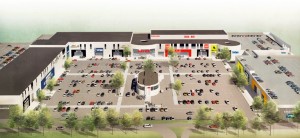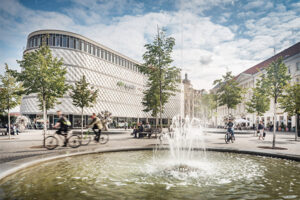According to the report, the surge in international demand for prime assets in the retail investment property market is driven by massive capital placement requirements coupled with limited risk tolerance. This is a very difficult combination in a market characterized by historically low returns on investment-grade bonds, which are traditionally more liquid.
In a global context, the defensive qualities of prime retail properties in terms of lower vacancy risk and a track record of inflation-hedged returns have served to fuel investment demand in mature markets like the United States, the UK, and Germany, but also in places like Denmark. Inter-national investors highly skilled in retail development are increasingly active players in the retail market. These specifically target high-street locations and well functioning shopping centers as part of their strategies. On account of a shift in consumer patterns in favor of prime retail areas and major shopping centers with a wider offering of shops, certain retail locations have posted increasing retail sales in recent years, even if overall consumer spending in general has declined. In addition, the retail market is seeing the effects of a sharp increase in online sales, increasing the demand for high-profile units and spacious showroom facilities to boost the shops’ online sales and give customers an attractive shopping experience.
The “location, location, location” maxim of the past has therefore become even more pertinent in today’s retail market. Indeed, location is predicted to become an even stronger parameter in the years ahead.
RETAIL PRIME RENTS DRIVEN UP
The combination of strong rental demand and a limited supply of prime units has historically served to drive up prime rents in the retail segment in nominal and real terms. This does not apply to the market for prime office space, however, where the substantial availability of well-located development areas in the vicinity of Copenhagen has put a cap on achievable rents. This has been one of the factors inducing core investors, in particular, to reduce yield requirements on prime retail assets to a very low level relative to the yields required on the prime office properties.
The investment market for secondary retail properties outside Copenhagen is still suffering from the slump in retail spending and a loss of market share to regional shopping centers in fierce competition for customers. With the decline in sales translating into increased vacancy risk and less ready financing, investment has weakened accordingly and risk premiums have started to climb. As a result, market liquidity has diminished and transaction activity in the secondary retail property market was very sluggish in 2013.
SCOTTISH STANDARD LIFE INVESTMENTS, MEYER BERGMAN, AND MORE
High street locations and department stores continue to be in heavy demand among investors due to increased earnings in this segment. Except when shopping for groceries, consumers increasingly tend to concentrate their shopping to a small area with a wide offering of shops which, apart from shopping centers, benefits in particular prime department stores and the Copenhagen high street, with the junction of Strøget and Købermagergade at Amagertorv being considered the top high-street location.
In 2013, the predominance of international investors on the buying side made it very clear that the demand from international investors remains unabated in Copenhagen high-street market. Scottish Standard Life Investments acquired the large develop-ment project at Frederiksberggade 40 as well as Købmagergade 3, Købmagergade 45 – 47, and Fredriksborggade 5, while the British investor Meyer Bergman acquired Købmagergade 32 and 48. In addition, the German investor Patrizia acquired Fredriksberggade 24 and the British investor InfraRed Capital Partners took on Frederiksborggade 12.
Two domestic investors were also active buyers in the high-street market in 2013, however. At the end of the year, the pension funds ATP and PFA acquired the popular department store Magasin du Nord, situated in a central location at Kongens Nytorv. Comprising about 58,000 sq m of space and let on a 20-year lease, the department store traded at an estimated price of DKK 2 billion (€270 million). This transaction proves that institutional investors are in pursuit of core products in all property segments, provided their volume requirements are met.

In the Copenhagen high-street market, nominal and real increases in rent levels and a surge in the demand for low risk assets have driven down yield requirements in prime and secondary locations alike, which today stand at 4.5% and 5.25% respectively.
THE VIEW OF GREATER COPENHAGEN
In Greater Copenhagen, prime shopping centers continue to attract strong demand from core investors. Like the high-street market, demand in this segment is driven largely by foreign investors. Active international investors in this segment typically possess special skills in regard to the optimization and operation of shopping centers.
However, despite strong international demand, the number of transactions in the segment remains very low. The first reason for this is that supply is quite limited. Secondly, as in the United States, ownership is concentrated in very few hands, with Dades and Danica Pension being the largest Danish owners by far. Combined, they own most of Denmark’s major and attractive shopping centers, and due to the long-term investment horizons of both companies, only a very few prime shopping centers are put on the market in Copenhagen or Denmark in general, despite the strong demand.
As a result, no major prime shopping centers were traded in Greater Copenhagen in 2013. In fact, however, the largest transaction in Denmark the same year was the sale of the approximately 140,000-sq-m Rosengårdcentret, situated in Odense on the island of Funen, to the German investment management company ECE, with the domestic company ATP as co-owner.
NREP ACQUIRED TWO MINOR SHOPPING CENTERS
The market is seeing signs of renewed risk tolerance and an increase in demand for local shopping centers, although this segment has been reeling from the repercussions of the slowdown in consumer spending. The demand for local shopping centers is concentrated on centers with a strong catchment area and typically anchored by grocery shops. Such centers have attracted attention from investors, who are willing to take on the risk carrying out the required developments and value-creation. For instance, in 2013, the Danish company NREP acquired two minor shopping centers, Frihedens Butikscenter and Holte Midpunkt, while a foreign investor acquired Rungsted Bytorv.

The investment market for big box properties remains sluggish, with continued weak investment demand. Recent years’ slump in consumer spending has hit the traditional big box tenants particularly hard, straining their sales and effectively impacting on their financial standing. As a result, investors’ yield requirements continue to climb, with the yield on prime properties increasing to around 6.75% in 2013, while the yield for secondary big box properties has increased to 8.25%, up from 7.75% in 2012.
The market for big box properties let to grocery stores has seen somewhat brisker activity, however, and not merely on account of the stronger tenants in this segment. Investors find it easier to assess the quality of the tenant and the exit risk associated with such properties, where the potential for revenue increases is relatively transparent and easily calculated on the basis of a comparative analysis of catchment area and competitors. In the years preceding the crisis, sustained strong rental demand in the grocery sector drove up rent levels in this segment, and despite the recent stagnant and downward trend in rents, demand continues to be fairly strong.
CHALLENGES FOR BIG BOXES
Another challenge facing the big box segment is the availability of new facilities at relatively low construction costs and building values, making users opt for new up-to-date facilities, rather than costly refurbishments of outdated existing facilities. The coming years are therefore expected to see some new construction starts in this segment fueled also by the centralization trend prevalent in consumer patterns (i.e. the preference of consumers for clusters of shopping opportunities within a confined geographical area, as seen in the high-street and regional shopping center markets).
This is exemplified by the development of the so-called DISA site in Herlev, northwest of Copenhagen. Formerly the home of a metal foundry facility, the site was acquired with a view to erecting a 40,000-sq-m retail outlet/shopping center with large shop united, ideally suited for H&M and big box retailers such as the domestic home electronics retailer Elgiganten.





